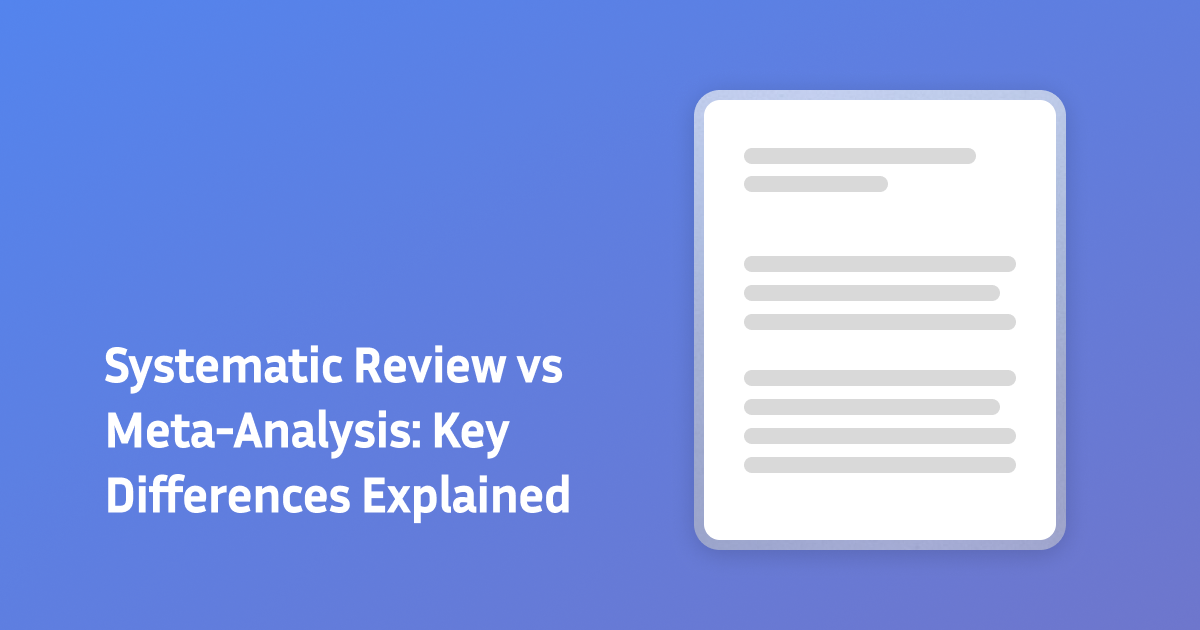Systematic Review vs Meta Analysis: Key Differences (2025)

Have you ever wondered why some research is considered more trustworthy than others? The terms "systematic review" and "meta-analysis" are often associated with high-quality evidence, but the distinction between the two can be quite confusing.
In this guide, we’ll break down these crucial research methods in 2025, explaining what sets them apart and how each contributes to a deeper understanding of academic research.
Quick Comparison of Systematic Review Vs Meta Analysis
| Feature | Systematic Review | Meta-Analysis |
|---|---|---|
| Definition | Comprehensive review that identifies, evaluates, and synthesizes all available evidence on a specific question | Statistical technique that combines results from multiple similar studies to calculate an overall effect |
| Primary Purpose | To gather and critically appraise all relevant research | To provide a precise mathematical estimate of effect |
| Nature | Primarily qualitative synthesis | Primarily quantitative analysis |
| Study Types Included | Can include diverse study designs | Requires studies with compatible numerical data |
| Approach to Evidence | Comprehensive and inclusive | Selective based on statistical compatibility |
| Analysis Method | Narrative synthesis, thematic analysis | Fixed or random effects models, meta-regression |
| Time Required | 6–12 months typically | 9–18 months (includes systematic review phase) |
The Research Pyramid: Where Do They Fit?
Research evidence can be visualized as a pyramid:
- At the bottom: Individual studies (like single experiments or surveys)
- In the middle: Reviews that summarize multiple studies
- Near the top: Systematic reviews that methodically analyze many studies
- At the very top: Meta-analyses that statistically combine results from multiple studies
Both systematic reviews and meta-analyses are considered the "gold standard" in research because they look at the big picture rather than isolated findings. [1]

What Is a Systematic Review?
A systematic review is a rigorous, structured research method that aims to identify, evaluate, and summarize all available evidence on a specific research question.[2] Unlike traditional literature reviews, systematic reviews follow strict, predefined protocols to minimize bias and provide the most comprehensive overview possible.
The primary purposes of a systematic review are to:
- Gather all existing evidence on a particular topic
- Evaluate the quality of that evidence
- Create a transparent summary that answers a specific research question
- Identify gaps in current knowledge
- Inform evidence-based practice and policy decisions
💡While systematic reviews traditionally require extensive manual work, tools like Paperguide can streamline the process by helping researchers discover and gather existing research more efficiently, extract relevant data systematically, and identify knowledge gaps with greater precision.
Key Steps in Conducting a Systematic Review
Creating a high-quality systematic review involves following these essential steps:
- Formulate a clear research question: Often using frameworks like PICO (Population, Intervention, Comparison, Outcome)
- Develop a protocol: Create a detailed plan that outlines your methods before you begin
- Conduct a comprehensive search: Search multiple databases, journals, gray literature, and reference lists using carefully crafted search strategies
- Screen and select studies: Apply predefined inclusion/exclusion criteria to determine which studies qualify
- Extract data: Systematically collect relevant information from each included study using standardized forms
- Assess study quality: Evaluate the methodological rigor and risk of bias in each study
- Synthesize findings: Combine results, either narratively or, when appropriate, statistically
- Present results: Report findings following established guidelines like PRISMA (Preferred Reporting Items for Systematic Reviews and Meta-Analyses) [3]

Advantages and Limitations
Advantages:
- Comprehensive: Captures the full landscape of available evidence [4]
- Reduces bias: Predefined methods limit cherry-picking of studies [4]
- Transparency: Clear documentation allows others to verify your work [4]
- Evidence mapping: Identifies knowledge gaps for future research [4]
- Flexibility: Can incorporate diverse study designs when appropriate [4]
Limitations:
- Time-intensive: Often takes 6-18 months to complete properly
- Resource-heavy: Typically requires a team rather than a single researcher
- Publication bias: May still be affected by unpublished negative results
- Rapidly outdated: New evidence can quickly make findings obsolete
- Quality limitations: Can only be as good as the studies it includes
What Is a Meta-Analysis?
A meta-analysis is a statistical procedure that combines the numerical results from multiple similar studies to calculate an overall effect size.[5] Think of it as a "study of studies" that uses statistical methods to find the signal amid the noise of individual research findings.
While a systematic review asks, "What does all the evidence say?", a meta-analysis asks more specifically, "What is the mathematical average effect across all studies, and how confident can we be in this number?"
The scope of a meta-analysis is more focused than a systematic review because studies must report compatible statistical outcomes that can be mathematically combined. This means a meta-analysis typically includes fewer studies than the systematic review it might be based on.
How Meta-Analysis Builds on Systematic Reviews
A meta-analysis typically builds upon a systematic review in the following way: [6]
- Starts with systematic review methods: Uses the same rigorous search and selection process
- Additional data requirements: Requires studies to report compatible statistical outcomes (means, standard deviations, effect sizes, etc.)
- Statistical pooling: While systematic reviews can stop at narrative synthesis, meta-analyses apply statistical methods to combine results
- Weighting: Gives more influence to larger or more precise studies
- Heterogeneity analysis: Examines why results might differ across studies
- Subgroup analysis: Can investigate if effects differ between certain types of participants or interventions

Benefits and Drawbacks
Benefits:
- Increased statistical power: Can detect effects that individual studies miss
- Precision: Provides confidence intervals around the true effect size
- Consistency assessment: Measures how much results vary across studies
- Moderator analysis: Can identify factors that influence the strength of effects
- Resolves contradictions: Helps determine the overall direction of evidence when studies conflict
Drawbacks:
- "Apples and oranges" problem: May inappropriately combine studies that are too different
- Garbage in, garbage out: Poor-quality input studies lead to unreliable conclusions
- Statistical complexity: Requires specialized expertise and software
- Oversimplification: A single number can mask important nuances
- Publication bias: Positive results are more likely to be published, potentially inflating effect sizes. [7]
Paperguide can support the meta-analysis process by helping researchers efficiently collect compatible studies, extract standardized data points, and organize statistical information – making what was once a highly complex technical process more accessible to researchers at all levels.
Main Differences Between Systematic Review and Meta-Analysis
| Feature | Systematic Review | Meta-Analysis |
|---|---|---|
| Definition | A comprehensive, transparent method to identify, evaluate and summarize all evidence on a specific question | A statistical method that combines numerical results from similar studies to calculate an overall effect |
| Primary purpose | To gather and critically appraise all relevant research | To provide a precise mathematical estimate of effect |
| Nature | Primarily qualitative synthesis | Primarily quantitative analysis |
| Question scope | Can be broader with multiple components | Must be narrow with specific measurable outcomes |
| Study types included | Can include diverse study designs | Requires studies with compatible numerical data |
| Approach to evidence | Comprehensive and inclusive | Selective based on statistical compatibility |
| Required expertise | Literature searching, critical appraisal | Statistical methods, effect size calculation |
| Main steps | Protocol development, searching, screening, data extraction, quality assessment, synthesis | All systematic review steps plus statistical pooling of results |
| Analysis method | Narrative synthesis, thematic analysis, content analysis | Fixed or random effects models, meta-regression, subgroup analysis |
| Output format | Text summary, evidence tables, narrative synthesis | Forest plots, pooled effect sizes, confidence intervals |
| Heterogeneity handling | Described qualitatively | Measured statistically (I², Q-test) |
| Bias assessment | Risk of bias tools, quality assessment checklists | Publication bias tests, funnel plots, sensitivity analyses |
| Typical conclusion | "The evidence suggests that..." | "The pooled effect size is X (95% CI: Y-Z)" |
| Time required | 6-12 months typically | 9-18 months (includes systematic review phase) |

Types of Systematic Reviews
Systematic reviews aren't one-size-fits-all. Different review types are used depending on the research goal:
1. Effectiveness Reviews
Evaluate the impact of an intervention or treatment (often paired with meta-analysis).
2. Diagnostic Test Accuracy Reviews
Assess how well diagnostic tests identify a condition, often using sensitivity and specificity.
3. Prognostic Reviews
Examine how certain factors affect future outcomes, commonly used in clinical research.
4. Qualitative Evidence Syntheses
Summarize qualitative studies to understand experiences, values, or perspectives on a topic.
5. Prevalence/Incidence Reviews
Summarize data on how common a condition or phenomenon is across populations.
6. Etiology/Risk Reviews
Explore potential causes or risk factors for diseases, behaviors, or outcomes.
7. Scoping Reviews
Map the breadth and key concepts of a topic—ideal for emerging or complex areas.
8. Umbrella Reviews
Summarize evidence from multiple existing systematic reviews (also called overviews of reviews).
When to Use a Systematic Review or Meta-Analysis
Understanding when to use each method will help you choose the right approach for your research needs.
Research Scenarios and Use Cases
Choose a Systematic Review When:
- Your question covers diverse types of research Example: "How does screen time affect child development?" – This question involves various study designs, outcomes, and age groups that would be difficult to combine statistically.
- You need to map what's known and unknown Example: "What interventions exist for supporting first-generation college students?" – A systematic review helps identify patterns and gaps across the literature.
- Your topic includes qualitative elements Example: "How do patients experience telehealth services?" – This question requires including qualitative studies that explore patient perspectives.
- You want to examine multiple outcomes Example: "What are the effects of exercise on mental health?" – This broad question covers many different mental health outcomes that may not be measurable in the same way.
Choose a Meta-Analysis When:
- You need a precise answer about an effect size Example: "How effective is medication X compared to medication Y for reducing blood pressure?" – A meta-analysis provides a specific numerical answer.
- Multiple similar studies show conflicting results Example: "Does homework improve academic achievement?" – When some studies say yes and others say no, meta-analysis can resolve the contradiction.
- You want to know if effects differ across groups Example: "Is cognitive behavioral therapy more effective for anxiety or depression?" – Meta-analysis can compare effects across subgroups.
- You need statistical power that individual studies lack Example: "Does vitamin D supplementation reduce fracture risk?" – Combining multiple smaller studies increases your ability to detect real effects.
Choosing the Right Method
Ask yourself these simple questions to decide:
- What's my main goal?
- To get a comprehensive overview → Systematic review
- To calculate a precise effect → Meta-analysis
- What kind of studies exist on my topic?
- Diverse study types with different methods → Systematic review
- Similar quantitative studies → Meta-analysis
- What does my audience need?
- Broad understanding of evidence → Systematic review
- Specific numbers and statistical certainty → Meta-analysis
- Quick Decision Guide:
- If studies measure outcomes in different ways → Systematic review
- If studies measure outcomes similarly → Meta-analysis possible
- If you need both breadth and precision → Consider a systematic review with meta-analysis where possible
Remember that you can conduct a systematic review first, then perform a meta-analysis on studies that are similar enough to combine statistically. This approach often gives you the best of both worlds.

Real-World Examples to Make It Click
Systematic Review Example
Research Question: How effective are mindfulness interventions for college student stress?
A systematic review might find 35 studies on this topic and report: [8]
- 25 studies found positive effects
- 7 showed mixed results
- 3 found no significant benefit
- Quality of evidence varied from low to moderate
- Different interventions ranged from 2-week to semester-long programs
- Conclusion: Mindfulness appears promising but more rigorous research is needed
Meta-Analysis Example
Research Question: How effective are mindfulness interventions for college student stress?
A meta-analysis might take those same 35 studies but: [8]
- Only include 18 that measured stress in similar ways
- Calculate that mindfulness interventions reduce stress by an average of 0.42 standard deviations (a moderate effect)
- Show that longer programs (8+ weeks) have significantly better results
- Demonstrate that effects are stronger for high-stress majors
- Conclusion: Mindfulness reduces student stress (moderate effect, 95% confidence interval: 0.31-0.53), with better results from longer programs
Frequently Asked Questions
1. Can a paper be both a systematic review AND a meta-analysis?
Absolutely! In fact, many research papers combine both approaches. The typical workflow is:
- First, researchers conduct a comprehensive systematic review to identify all relevant studies
- Then, they perform a meta-analysis on the subset of studies that report compatible quantitative data
- The paper presents both the broader qualitative synthesis and the more specific statistical analysis
These are often titled "A Systematic Review and Meta-Analysis of..." to indicate that both methods were used.
2. Which one should I use for my research project?
The choice depends on your specific research question and the available literature:
Choose a systematic review when:
- Your question covers diverse types of evidence
- The literature includes varied study designs
- You need a comprehensive overview of all evidence
- Studies use inconsistent outcome measures
- You want to identify research gaps
Choose a meta-analysis when:
- Your question seeks a precise effect estimate
- The literature contains multiple similar studies
- You need to resolve conflicting study results
- Studies use comparable outcome measures
- You want to explore factors that modify effects
3. Are these methods only used in medical research?
Not at all! While these methods originated in healthcare, they've expanded to virtually every academic field:
- Psychology: Meta-analyses of therapeutic approaches, educational interventions
- Education: Systematic reviews of teaching methodologies, technology integration
- Environmental Science: Meta-analyses of conservation strategies, climate interventions
- Business: Systematic reviews of management practices, marketing approaches
- Social Sciences: Meta-analyses of policy interventions, behavioral programs
- Sports Science: Systematic reviews of training methods, performance enhancement
4. What tools and resources do I need to get started?
For beginners interested in these methods, here are some essential resources:
For Systematic Reviews:
- Guidelines: PRISMA (Preferred Reporting Items for Systematic Reviews and Meta-Analyses)
- Screening tools: Covidence, Rayyan, or DistillerSR
- Protocol registration: PROSPERO database
- Quality assessment tools: Cochrane Risk of Bias Tool, CASP checklists
For Meta-Analysis:
- Statistical software: R (with metafor package), Comprehensive Meta-Analysis, RevMan
- Effect size calculators: Campbell Collaboration calculators
- Reporting guidelines: PRISMA, MOOSE (for observational studies)
- Books: "Introduction to Meta-Analysis" by Borenstein et al.
Additional FAQs
1. Can a systematic review include both qualitative and quantitative studies?
Yes. Many systematic reviews use a mixed-methods approach, combining statistical meta-analysis with narrative synthesis of qualitative findings for a more complete understanding.
2. When is meta-analysis not appropriate?
Meta-analysis isn’t suitable when studies are too heterogeneous (different populations, methods, or outcomes), lack comparable statistics, or when data reporting is too inconsistent.
3. How does publication bias affect meta-analysis results?
When studies with negative or non-significant results remain unpublished, meta-analyses can overestimate effects. Tools like funnel plots help detect this bias.
4. What is a forest plot and how do I read one?
A forest plot is a visual representation of each study’s effect size and the overall pooled estimate. Each line shows a study’s result and confidence interval—if most overlap and align on one side of the line of no effect, results are more conclusive.
5. Are scoping reviews the same as systematic reviews?
Not exactly. Scoping reviews aim to map the available literature and identify gaps, while systematic reviews synthesize the evidence to answer a specific question with more rigor and often include quality appraisal.
Practical Applications in Different Fields
Understanding how these methods are applied can help clarify their value:
In Healthcare:
- Systematic reviews inform clinical practice guidelines
- Meta-analyses determine the most effective treatments
In Education:
- Systematic reviews identify effective teaching strategies
- Meta-analyses quantify the impact of educational interventions
In Psychology:
- Systematic reviews map therapeutic approaches for specific conditions
- Meta-analyses compare effectiveness across different therapies
In Policy Development:
- Systematic reviews compile evidence on policy outcomes
- Meta-analyses calculate return-on-investment for programs
Key Takeaways
If you remember nothing else from this article, keep these essential points in mind:
- Systematic reviews are comprehensive, transparent summaries of all available evidence on a specific question
- Meta-analyses are statistical methods that combine numerical results from similar studies to calculate an overall effect
- The relationship: A meta-analysis typically follows a systematic review, but not all systematic reviews include meta-analysis
- Purpose: Systematic reviews provide breadth of understanding; meta-analyses provide precision
- Evidence hierarchy: Both methods sit at the top of the evidence pyramid, offering more reliable conclusions than individual studies.[10]
Conclusion
Understanding systematic reviews and meta-analyses gives you powerful tools to:
- Evaluate research claims more critically
- Identify the strongest evidence in your field
- Plan more impactful research projects
- Contribute meaningfully to evidence-based practice
As you continue your academic journey, these research methods will help you navigate the vast sea of scientific literature with greater confidence. You'll be able to distinguish between isolated findings and well-established knowledge, making you a more discerning consumer and producer of research.
Remember that even experienced researchers once stood where you are now, learning these concepts for the first time. Each step you take in understanding research methods brings you closer to making your own valuable contributions to knowledge.
What research questions in your field might benefit from these powerful approaches? The answers await your discovery!
Frequently Asked Questions (FAQs)
Q1: Can a paper be both a systematic review and a meta-analysis?
A1: Yes, many research papers combine both methods to provide both a broad synthesis and precise statistical analysis.
Q2: Which method should I use for my research in 2025?
A2: Choose a systematic review if you need a comprehensive overview or your studies are diverse. Opt for a meta-analysis if you need a precise effect size and the studies are similar.
Q3: Are these methods only used in medical research?
A3: No, systematic reviews and meta-analyses are used across various fields, including psychology, education, business, and environmental science.
Q4: What tools do I need for conducting these reviews in 2025?
A4: Common tools include PRISMA guidelines, Covidence, and R for meta-analysis.
References
- Murad, M. H., Asi, N., Alsawas, M., & Alahdab, F. (2016). New evidence pyramid. BMJ Evidence-Based Medicine, 21(4), 125-127.
- Gough, D., Oliver, S., & Thomas, J. (2017). An introduction to systematic reviews (2nd ed.). SAGE Publications.
- Page, M. J., McKenzie, J. E., Bossuyt, P. M., Boutron, I., Hoffmann, T. C., Mulrow, C. D., ... & Moher, D. (2021). The PRISMA 2020 statement: An updated guideline for reporting systematic reviews. BMJ, 372, n71.
- Centre for Reviews and Dissemination. (2009). Systematic Reviews: CRD's guidance for undertaking reviews in health care. University of York.
- Borenstein, M., Hedges, L. V., Higgins, J. P. T., & Rothstein, H. R. (2009). Introduction to meta-analysis. Wiley.
- Haidich, A. B. (2010). Meta-analysis in medical research. Hippokratia, 14(Suppl 1), 29–37.
- Dwan, K., Gamble, C., Williamson, P. R., & Kirkham, J. J. (2013). Systematic review of the empirical evidence of study publication bias and outcome reporting bias. PLOS ONE, 8(7), e66844.
- Khoury, B., Sharma, M., Rush, S. E., & Fournier, C. (2015). Mindfulness-based stress reduction for healthy individuals: A meta-analysis. Journal of Psychosomatic Research, 78(6), 519-528.
- Petticrew, M., & Roberts, H. (2006). Systematic reviews in the social sciences: A practical guide. Blackwell Publishing.
- Murad, M. H., Asi, N., Alsawas, M., & Alahdab, F. (2016). New evidence pyramid. BMJ Evidence-Based Medicine, 21(4), 125-127.





